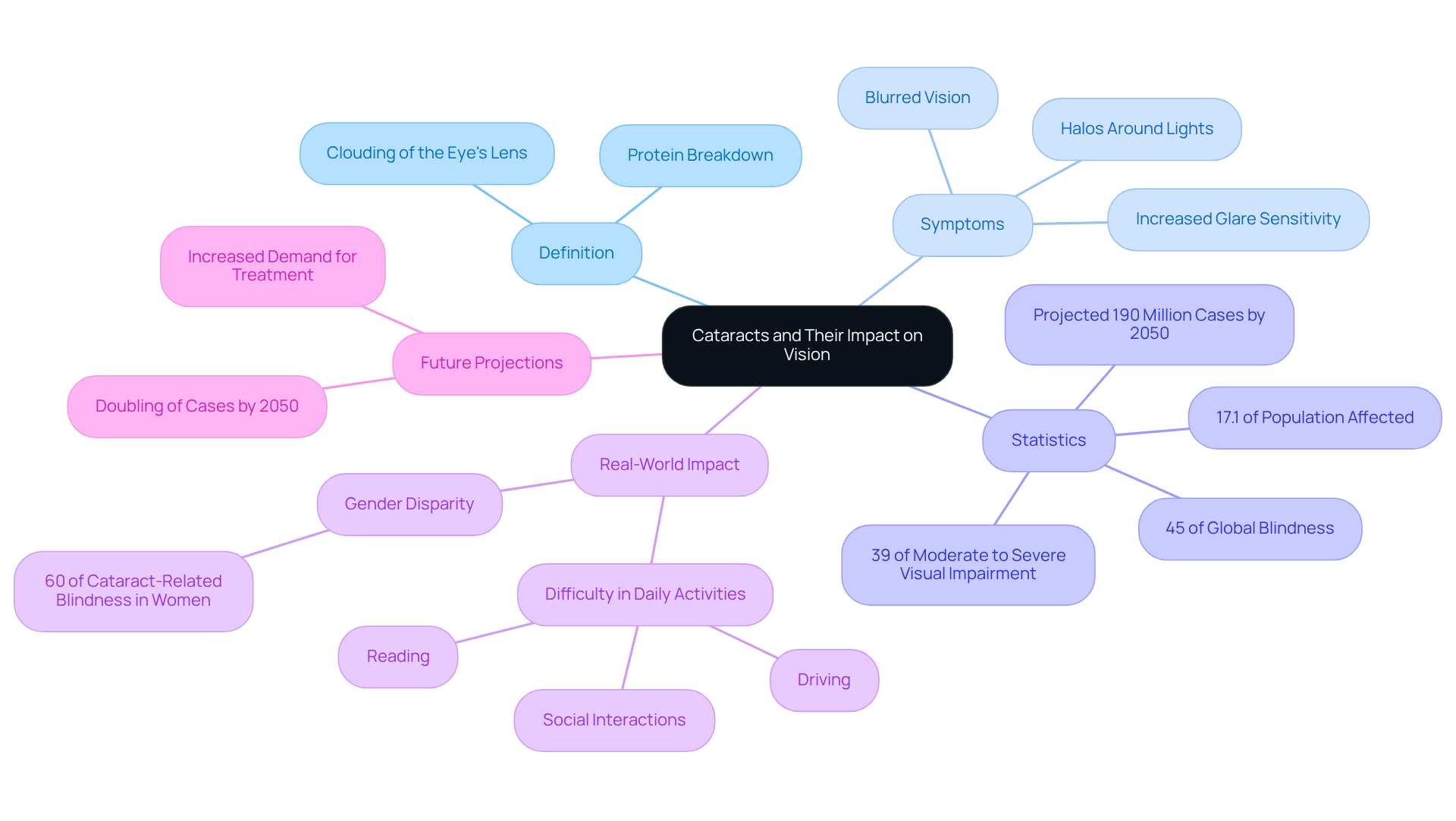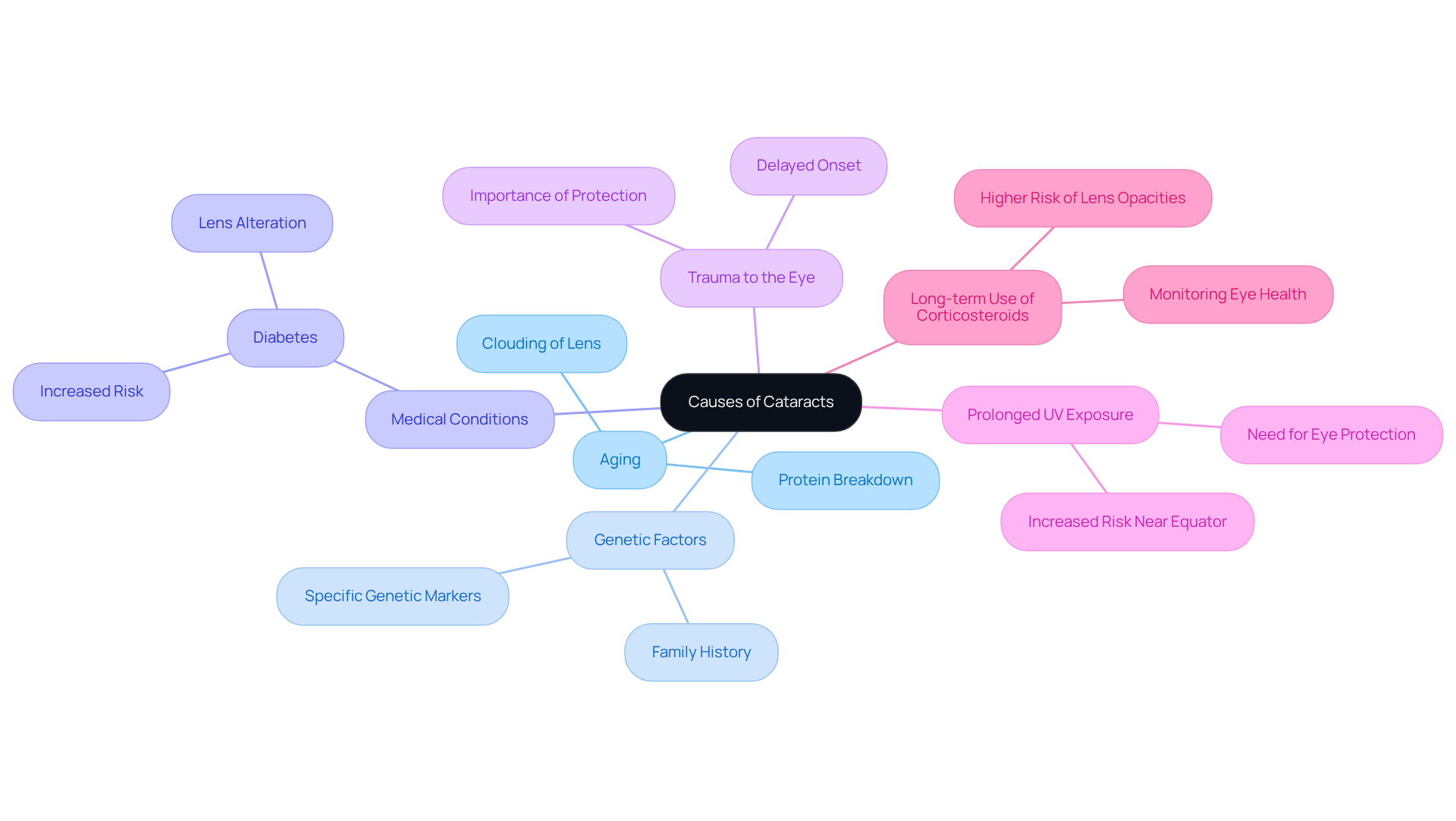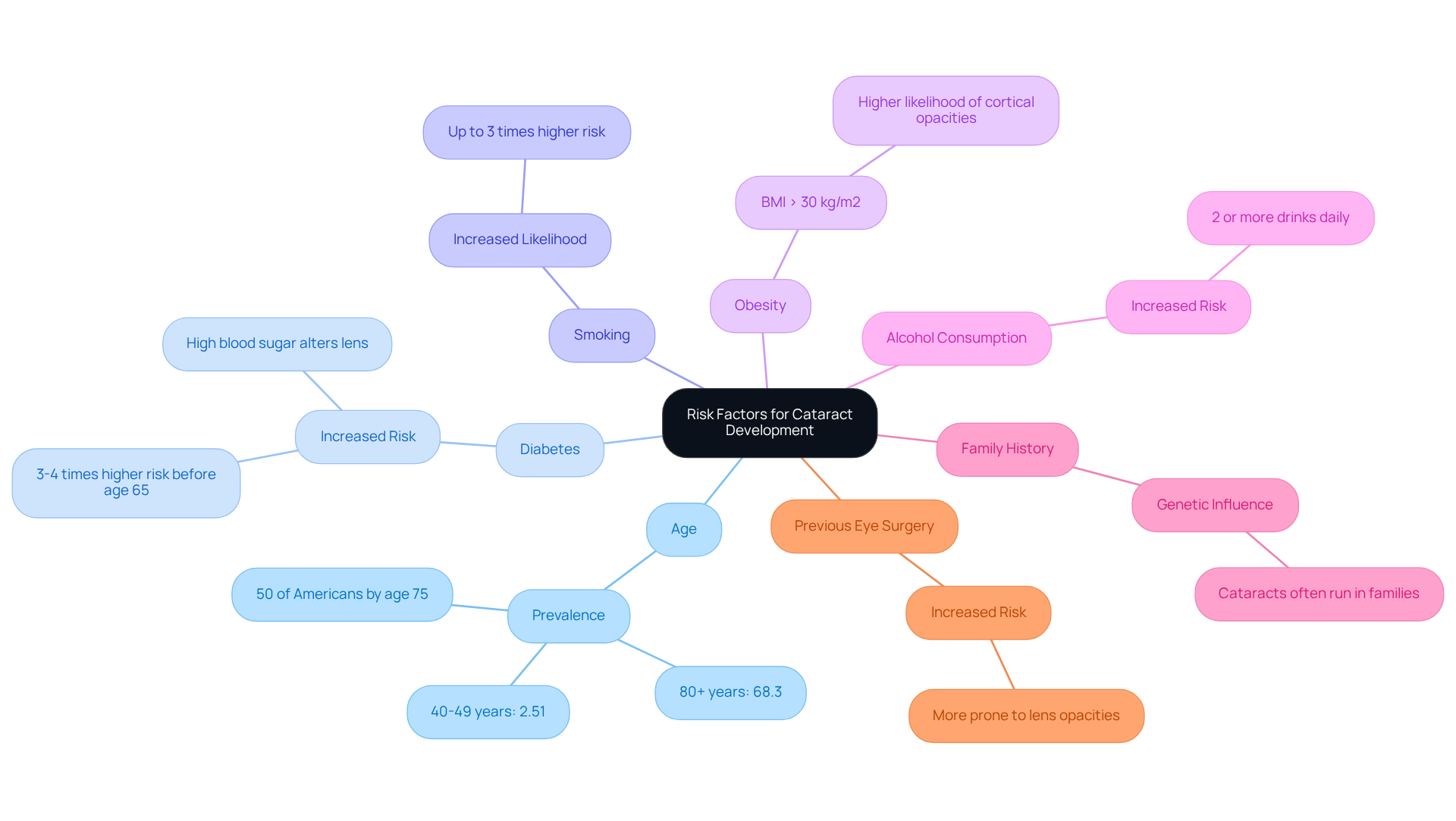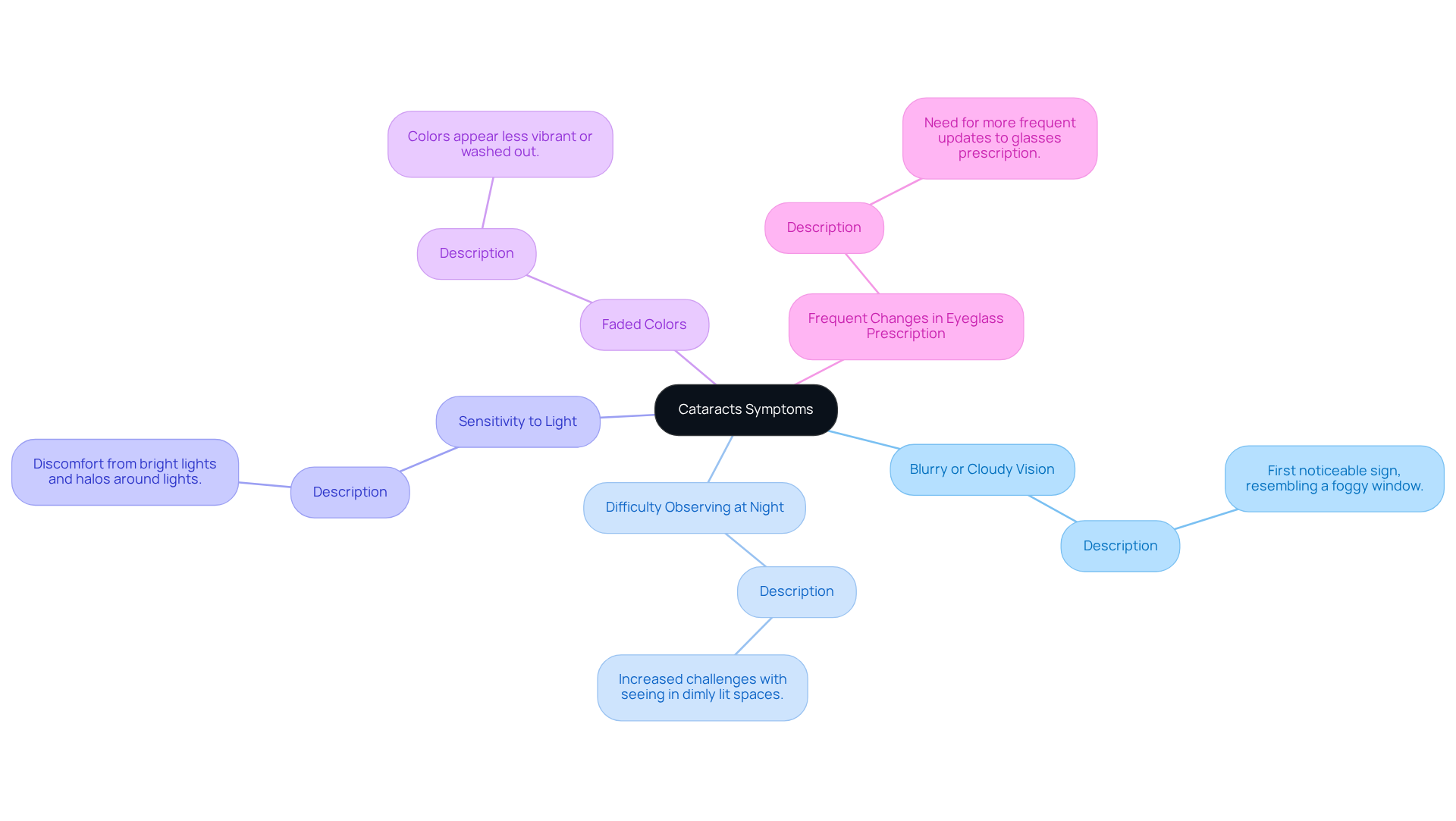Posted by: Northwest Eye in Cataracts, Vision Correction on November 12, 2025
Introduction
Cataracts can be a daunting challenge for many, clouding the natural lens of the eye and gradually diminishing vision. We understand that as you age, the risk of developing cataracts increases, influenced by factors like genetics, medical conditions, and lifestyle choices. With nearly half of the global population affected by this condition, it’s crucial to recognize the symptoms and understand the underlying causes to manage your eye health proactively.
It’s common to feel overwhelmed by the complexities of cataract development and its impact on daily life. But you’re not alone in this journey. Many have navigated these challenges and found effective solutions for clearer vision. We are here to help you through this process, providing the support and information you need to make informed decisions about your eye health.
Define Cataracts and Their Impact on Vision
Cataracts can feel overwhelming, as they represent a clouding of the eye’s natural lens, which is usually clear. This condition develops when proteins within the lens break down and clump together, leading to a gradual loss of transparency. As these lens opacities progress, they can significantly hinder your sight, making everything seem blurred, hazy, or less vivid.
We understand that many patients report difficulties with night vision, increased sensitivity to light, and the perception of halos around lights. These halos appear as bright circles surrounding light sources, like headlights, and can be especially noticeable in dim or dark environments. Additionally, glare—light that interferes with vision—can become more pronounced during the daytime.
Statistics show that lens opacities affect around 17.1% of the total population, with the occurrence rising notably with age—from 2.51% in people aged 40-49 to 68.3% in those 80 and above. Cataracts are responsible for nearly 45% of global blindness, underscoring the seriousness of this condition.
The impact of lens opacities on daily life can be significant. Tasks like reading, driving, and recognizing faces can become increasingly difficult. For instance, a study revealed that lens opacities account for almost 39% of moderate to severe visual impairment, affecting approximately 78.8 million individuals worldwide. It’s important to note that women make up about 60% of cataract-related blindness cases, highlighting a notable gender disparity in the effects of this condition.
Real-world examples illustrate this impact: some individuals may find themselves avoiding social situations due to trouble seeing faces, or they may struggle with reading road signs while driving. Furthermore, around 30% of UK private eye surgery patients opt for premium intraocular lenses, showcasing advancements in treatment options.
Understanding the characteristics of lens opacity—such as blurred sight, halos, and glare—along with cataract causes and other potential factors like diabetic retinopathy and dry eyes, is crucial for recognizing when to seek prompt care. Untreated lens opacities can lead to significant vision impairment and a reduced quality of life.
Looking ahead, projections suggest that by 2050, the number of individuals with clouded lenses globally is expected to double from 95 million to nearly 190 million. This highlights the importance of awareness and taking action. Remember, we are here to help you through this process.

Explore Common Causes of Cataracts
Cataract causes can include various factors, with aging being the most common. As we age, the proteins in our lens naturally break down, leading to clouding. We understand that this can be concerning, so let’s explore some key contributors to cataract formation:
- Genetic Factors: If you have a family history of cataracts, your chances of developing the condition increase significantly. Research shows that genetic predisposition plays a vital role in lens opacities, with specific markers linked to higher incidence rates.
- Medical conditions: Such as diabetes, can speed up the development of lens opacities, which are among the cataract causes. Elevated blood sugar levels can alter the lens, raising the risk of clouding. In fact, people with diabetes are three to four times more likely to develop lens opacities before age 65 compared to those without the condition.
- Trauma to the eye: Can lead to clouding of the lens, which is one of the cataract causes that may occur years after the initial injury. This delayed onset highlights the importance of protecting your eyes from potential harm.
- Prolonged UV exposure: Is one of the cataract causes, as excessive sunlight exposure without proper eye protection can contribute to lens clouding. Those living closer to the equator, where UV exposure is greater, may face eye issues earlier in life.
- Long-term use of corticosteroids: And some other medications has been linked to a higher risk of cataract causes, including lens opacities. Being aware of these medications can help you monitor and manage your eye health.
Understanding these cataract causes is vital for prevention and early intervention. It empowers you to take proactive steps in managing your eye health.
At Northwest Eye, we’re here to support you with innovative solutions like the Light Adjustable Lens (LAL). This advanced intraocular lens allows for customized correction after cataract surgery. Imagine being able to fine-tune your vision post-surgery, enhancing your sight according to your lifestyle needs. With the LAL, you can experience a tailored approach to vision correction, ensuring the best possible outcomes and reducing your dependence on glasses. We are here to help you through this process.

Identify Risk Factors for Cataract Development
Several key risk factors can significantly increase the likelihood of developing cataract causes, and we understand that this can be concerning. Here’s what you should know:
- Age: The risk of cataracts escalates notably after age 40. For instance, the prevalence rises from 2.51% in individuals aged 40-49 to a striking 68.3% in those aged 80 and above. It’s estimated that about 50% of Americans will experience lens opacities by age 75, highlighting how common this condition is.
If you have diabetes, your risk of developing cataract causes, resulting in clouding of the lens before age 65, increases threefold to fourfold. Elevated blood sugar levels can alter the eye’s lens, hastening the development of clouding. For example, Frank, a 65-year-old with type 2 diabetes, noticed blurry vision and was diagnosed with lens opacities during a routine eye exam.
-
Smoking: Tobacco use is linked to up to three times the likelihood of lens clouding compared to non-smokers. This emphasizes the considerable impact smoking can have on your eye health.
-
Obesity: A body mass index exceeding 30 kg/m2 is associated with a higher likelihood of cortical lens opacities. Maintaining a healthy weight is crucial for your overall well-being.
-
Excessive Alcohol Consumption: Drinking two or more alcoholic beverages daily can significantly increase the risk of lens opacities.
Family history indicates that genetics play a role in the likelihood of developing cataract causes, as they often run in families. Interestingly, cataracts affect around 39% of men and 61% of women, indicating a gender disparity in prevalence.
- Previous Eye Surgery: If you’ve had eye surgery for other issues, you may be more prone to developing lens opacities.
By understanding these risk factors, you can take proactive steps to reduce your exposure. Adopting healthier lifestyle choices and managing existing health conditions can make a difference. We encourage you to schedule routine eye examinations, especially if you’re at increased risk, such as if you have diabetes or a family history of lens conditions. Remember, we are here to help you through this process.

Recognize Symptoms and Signs of Cataracts
Cataract causes a variety of symptoms that may significantly affect your daily life. We understand that noticing changes in your vision can be concerning. Here are some key indicators to watch for:
- Blurry or Cloudy Vision: This is often the first noticeable sign. You might find your vision gradually becoming blurred, much like looking through a foggy window.
- Difficulty Observing at Night: As cataracts progress, many patients report increased challenges with seeing at night, making it harder to navigate dimly lit spaces. It’s common to feel frustrated by these changes, and early detection is crucial.
- Sensitivity to Light: Bright lights may start to feel uncomfortable, and you might notice halos around lights, which can affect your overall visual comfort.
- Faded Colors: You may find that colors appear less vibrant or washed out, which can diminish the richness of your visual experiences.
- Frequent Changes in Eyeglass Prescription: If you wear glasses, you might notice that you need to update your prescription more often, indicating changes in your sight.
Identifying these symptoms early is vital for timely intervention, which can help preserve your quality of life and prevent serious sight impairment due to cataract causes. At Northwest Eye, we are here to support you with advanced treatment options, including the innovative Light Adjustable Lens (LAL). This unique lens reacts to UV light, allowing for customized adjustments after surgery to ensure optimal correction tailored to your lifestyle.
For instance, we had a patient who experienced blurred vision and difficulties with night vision. After seeking treatment and undergoing successful lens surgery, they saw a remarkable improvement in their overall sight and quality of life. With cataract surgeries performed without complications in over 95% of cases, early detection and treatment can lead to better outcomes. We encourage you to prioritize regular eye examinations, especially if you’re over 40. Remember, we are here to help you through this process.

Conclusion
Cataracts are a significant concern for vision health, often characterized by the clouding of the eye’s natural lens. We understand that this condition can impair sight and affect daily activities, making it crucial to recognize the various factors contributing to cataract development and the symptoms that signal its onset. By acknowledging the seriousness of cataracts, you can take steps to manage your eye health effectively.
Throughout this article, we’ve explored key points regarding the causes, risk factors, and symptoms of cataracts. Aging is the primary factor, but genetic predisposition, medical conditions like diabetes, and lifestyle choices such as smoking and excessive alcohol consumption can further increase the likelihood of developing this condition. Symptoms like blurred vision, sensitivity to light, and difficulty seeing at night are important indicators that should not be overlooked. Early detection and intervention are vital in preserving vision and enhancing your quality of life.
Ultimately, understanding cataracts and their impact on vision is essential for fostering awareness and prompting timely action. Regular eye examinations and adopting healthier lifestyle choices can significantly reduce the risk of developing cataracts. By prioritizing your eye health and seeking professional guidance, you can navigate the challenges posed by cataracts and work towards maintaining clearer, more vibrant vision. Remember, we are here to help you through this process.
Frequently Asked Questions
What are cataracts and how do they affect vision?
Cataracts are a clouding of the eye’s natural lens, which normally is clear. This condition occurs when proteins within the lens break down and clump together, leading to blurred, hazy, or less vivid vision. It can also cause difficulties with night vision, increased sensitivity to light, and the perception of halos around light sources.
What symptoms are commonly associated with cataracts?
Common symptoms of cataracts include blurred sight, halos around lights, glare during the daytime, and difficulty with night vision. These symptoms can significantly hinder daily activities such as reading, driving, and recognizing faces.
How prevalent are cataracts in the population?
Approximately 17.1% of the total population is affected by cataracts, with the occurrence increasing with age—from 2.51% in individuals aged 40-49 to 68.3% in those aged 80 and above.
What is the global impact of cataracts on blindness?
Cataracts are responsible for nearly 45% of global blindness, highlighting the seriousness of this condition. They account for about 39% of moderate to severe visual impairment, affecting approximately 78.8 million people worldwide.
Is there a gender disparity in cataract-related blindness?
Yes, women represent about 60% of cataract-related blindness cases, indicating a notable gender disparity in the effects of this condition.
What are some real-world consequences of cataracts?
Individuals with cataracts may avoid social situations due to difficulty seeing faces or struggle with reading road signs while driving. These challenges can significantly impact their quality of life.
What advancements exist in cataract treatment?
Around 30% of UK private eye surgery patients choose premium intraocular lenses, reflecting advancements in treatment options for cataracts.
What are the projected statistics for cataracts by 2050?
It is projected that the number of individuals with clouded lenses globally will double from 95 million to nearly 190 million by 2050, emphasizing the need for awareness and action regarding this condition.






